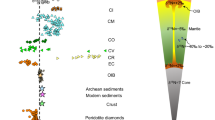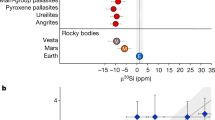Abstract
The abundances of volatile elements in the Earth’s mantle have been attributed to the delivery of volatile-rich material after the main phase of accretion1,2,3. However, no known meteorites could deliver the volatile elements, such as carbon, nitrogen, hydrogen and sulfur, at the relative abundances observed for the silicate Earth4. Alternatively, Earth could have acquired its volatile inventory during accretion and differentiation, but the fate of volatile elements during core formation is known only for a limited set of conditions4,5,6,7,8. Here we present constraints from laboratory experiments on the partitioning of carbon and sulfur between metallic cores and silicate mantles under conditions relevant for rocky planetary bodies. We find that carbon remains more siderophile than sulfur over a range of oxygen fugacities; however, our experiments suggest that in reduced or sulfur-rich bodies, carbon is expelled from the segregating core. Combined with previous constraints9, we propose that the ratio of carbon to sulfur in the silicate Earth could have been established by differentiation of a planetary embryo that was then accreted to the proto-Earth. We suggest that the accretion of a Mercury-like (reduced) or a sulfur-rich (oxidized) differentiated body—in which carbon has been preferentially partitioned into the mantle—may explain the Earth’s carbon and sulfur budgets.
This is a preview of subscription content, access via your institution
Access options
Subscribe to this journal
Receive 12 print issues and online access
$259.00 per year
only $21.58 per issue
Buy this article
- Purchase on Springer Link
- Instant access to full article PDF
Prices may be subject to local taxes which are calculated during checkout




Similar content being viewed by others
References
Wang, Z. & Becker, H. Ratios of S, Se and Te in the silicate Earth require a volatile-rich late veneer. Nature 499, 328–331 (2013).
Albarede, F. Volatile accretion history of the terrestrial planets and dynamic implications. Nature 461, 1227–1233 (2009).
Rose-Weston, L., Brenan, J. M., Fei, Y., Secco, R. A. & Frost, D. J. Effect of pressure, temperature, and oxygen fugacity on the metal-silicate partitioning of Te, Se, and S: implications for Earth differentiation. Geochim. Cosmochim. Acta 73, 4598–4615 (2009).
Bergin, E. A., Blake, G. A., Ciesla, F., Hirschmann, M. M. & Li, J. Tracing the ingredients for a habitable Earth from interstellar space through planet formation. Proc. Natl Acad. Sci. USA 112, 8965–8970 (2015).
Li, Y., Dasgupta, R. & Tsuno, K. The effects of sulfur, silicon, water, and oxygen fugacity on carbon solubility and partitioning in Fe-rich alloy and silicate melt systems at 3 GPa and 1600 °C: implications for core–mantle differentiation and degassing of magma oceans and reduced planetary mantles. Earth Planet. Sci. Lett. 415, 54–66 (2015).
Dasgupta, R., Chi, H., Shimizu, N., Buono, A. S. & Walker, D. Carbon solution and partitioning between metallic and silicate melts in a shallow magma ocean: implications for the origin and distribution of terrestrial carbon. Geochim. Cosmochim. Acta 102, 191–212 (2013).
Chi, H., Dasgupta, R., Duncan, M. S. & Shimizu, N. Partitioning of carbon between Fe-rich alloy melt and silicate melt in a magma ocean–Implications for the abundance and origin of volatiles in Earth, Mars, and the Moon. Geochim. Cosmochim. Acta 139, 447–471 (2014).
Rubie, D. C. et al. Accretion and differentiation of the terrestrial planets with implications for the compositions of early-formed solar system bodies and accretion of water. Icarus 248, 89–108 (2015).
Boujibar, A. et al. Metal–silicate partitioning of sulphur, new experimental and thermodynamic constraints on planetary accretion. Earth Planet. Sci. Lett. 391, 42–54 (2014).
Wood, B. J., Halliday, A. N. & Rehkamper, M. Volatile accretion history of the Earth. Nature 467, E6–E7 (2010).
Wood, B. J., Li, J. & Shahar, A. Carbon in the core: its influence on the properties of core and mantle. Rev. Mineral. Geochem. 75, 231–250 (2013).
Labidi, J., Cartigny, P. & Moreira, M. Non-chondritic sulphur isotope composition of the terrestrial mantle. Nature 501, 208–211 (2013).
Savage, P. S. et al. Copper isotope evidence for large-scale sulphide fractionation during Earth’s differentiation. Geochem. Perspect. Lett. 1, 53–64 (2015).
Schönbächler, M., Carlson, R. W., Horan, M. F., Mock, T. D. & Hauri, E. H. Heterogeneous accretion and the moderately volatile element budget of Earth. Science 328, 884–887 (2010).
Horita, J. & Polyakov, V. B. Carbon-bearing iron phases and the carbon isotope composition of the deep Earth. Proc. Natl Acad. Sci. USA 112, 31–36 (2015).
Rosenthal, A., Hauri, E. & Hirschmann, M. Experimental determination of C, F, and H partitioning between mantle minerals and carbonated basalt, CO2/Ba and CO2/Nb systematics of partial melting, and the CO2 contents of basaltic source regions. Earth Planet. Sci. Lett. 412, 77–87 (2015).
McDonough, W. F. & Sun, S.-S. The composition of the Earth. Chem. Geol. 120, 223–253 (1995).
Bouchard, D. B. & Bale, C. W. Simultaneous optimization of thermochemical data for liquid iron alloys containing C, N, Ti, Si, Mn, S, and P. Metall. Mater. Trans. B 26, 467–484 (1995).
Tsymbulov, L. B. & Tsemekhman, L. S. Solubility of carbon in sulfide melts of the system Fe-Ni-S. Russ. J. Appl. Chem. 74, 925–929 (2001).
Wang, C., Hirama, J., Nagasaka, T. & Ban-Ya, S. Phase equilibrium of liquid Fe-S-C ternary system. ISIJ Int. 31, 1292–1299 (1991).
Tsuno, K. & Dasgupta, R. Fe–Ni–Cu–C–S phase relations at high pressures and temperatures—The role of sulfur in carbon storage and diamond stability at mid- to deep-upper mantle. Earth Planet. Sci. Lett. 412, 132–142 (2015).
Deng, L., Fei, Y., Liu, X., Gong, Z. & Shahar, A. Effect of carbon, sulfur and silicon on iron melting at high pressure: implications for composition and evolution of the planetary terrestrial cores. Geochim. Cosmochim. Acta 114, 220–233 (2013).
Zhang, Z., Lentsch, N. & Hirschmann, M. M. Carbon-saturated monosulfide melting in the shallow mantle: solubility and effect on solidus. Contrib. Mineral. Petrol. 170, 1–13 (2015).
Armstrong, L. S., Hirschmann, M. M., Stanley, B. D., Falksen, E. G. & Jacobsen, S. D. Speciation and solubility of reduced C–O–H–N volatiles in mafic melt: implications for volcanism, atmospheric evolution, and deep volatile cycles in the terrestrial planets. Geochim. Cosmochim. Acta 171, 283–302 (2015).
Marty, B. The origins and concentrations of water, carbon, nitrogen and noble gases on Earth. Earth Planet. Sci. Lett. 313, 56–66 (2012).
Malavergne, V., Toplis, M. J., Berthet, S. & Jones, J. Highly reducing conditions during core formation on Mercury: implications for internal structure and the origin of a magnetic field. Icarus 206, 199–209 (2010).
McCubbin, F. M., Riner, M. A., Vander Kaaden, K. E. & Burkemper, L. K. Is Mercury a volatile-rich planet? Geophys. Res. Lett. 39, L09202 (2012).
Peplowski, P. N. et al. Constraints on the abundance of carbon in near-surface materials on Mercury: results from the MESSENGER Gamma-Ray Spectrometer. Planet. Space. Sci. 108, 98–107 (2015).
Syal, M. B., Schultz, P. H. & Riner, M. A. Darkening of Mercury’s surface by cometary carbon. Nat. Geosci. 8, 352–356 (2015).
Wohlers, A. & Wood, B. J. A Mercury-like component of early Earth yields uranium in the core and high mantle 142Nd. Nature 520, 337–340 (2015).
Tsuno, K. & Dasgupta, R. Melting phase relation of nominally anhydrous, carbonated pelitic-eclogite at 2.5–3.0 GPa and deep cycling of sedimentary carbon. Contrib. Mineral. Petrol. 161, 743–763 (2011).
Ding, S., Dasgupta, R. & Tsuno, K. Sulfur concentration of martian basalts at sulfide saturation at high pressures and temperatures–implications for deep sulfur cycle on Mars. Geochim. Cosmochim. Acta 131, 227–246 (2014).
Dasgupta, R. & Walker, D. Carbon solubility in core melts in a shallow magma ocean environment and distribution of carbon between the Earth’s core and the mantle. Geochim. Cosmochim. Acta 72, 4627–4641 (2008).
Helo, C., Longpré, M.-A., Shimizu, N., Clague, D. A. & Stix, J. Explosive eruptions at mid-ocean ridges driven by CO2-rich magmas. Nat. Geosci. 4, 260–263 (2011).
Duncan, M. S. & Dasgupta, R. CO2 solubility and speciation in rhyolitic sediment partial melts at 1.5–3.0 GPa–implications for carbon flux in subduction zones. Geochim. Cosmochim. Acta 124, 328–347 (2014).
O’Neill, H. S. C. & Eggins, S. M. The effect of melt composition on trace element partitioning: an experimental investigation of the activity coefficients of FeO, NiO, CoO, MoO2 and MoO3 in silicate melts. Chem. Geol. 186, 151–181 (2002).
Holzheid, A., Palme, H. & Chakraborty, S. The activities of NiO, CoO and FeO in silicate melts. Chem. Geol. 139, 21–38 (1997).
Ma, Z. Thermodynamic description for concentrated metallic solutions using interaction parameters. Metall. Mater. Trans. B 32, 87–103 (2001).
Acknowledgements
Y.L. thanks A. Boujibar for discussion on topics related to the present work. NASA grant NNX13AM51G to R.D. supported this work. R.D. also acknowledges a NSF grant EAR-1053816 that established the Rice University’s multi-anvil facility used in this study.
Author information
Authors and Affiliations
Contributions
Y.L. and R.D. conceived the project. Y.L. performed all the experiments, FTIR and Raman analyses of experimental glasses. B.M., Y.L. and N.S. performed the SIMS analyses. K.T. performed the electron microprobe analyses. Y.L. and R.D. analysed and interpreted all the data and co-wrote the paper. All authors commented on the manuscript.
Corresponding authors
Ethics declarations
Competing interests
The authors declare no competing financial interests.
Supplementary information
Supplementary Information
Supplementary Information (PDF 1882 kb)
Rights and permissions
About this article
Cite this article
Li, Y., Dasgupta, R., Tsuno, K. et al. Carbon and sulfur budget of the silicate Earth explained by accretion of differentiated planetary embryos. Nature Geosci 9, 781–785 (2016). https://doi.org/10.1038/ngeo2801
Received:
Accepted:
Published:
Issue Date:
DOI: https://doi.org/10.1038/ngeo2801
This article is cited by
-
Magma Ocean, Water, and the Early Atmosphere of Venus
Space Science Reviews (2023)
-
Nitrogen isotope evidence for Earth’s heterogeneous accretion of volatiles
Nature Communications (2022)
-
Redox geodynamics in Earth’s interior
Science China Earth Sciences (2022)
-
The core-merging giant impact in Earth’s accretion history and its implications
Acta Geochimica (2022)
-
Early planetary processes and light elements in iron-dominated cores
Acta Geochimica (2022)



